A section in Chapter 4 of the book:
Prep Lists for Camping, Hiking, and Backpacking
When selecting an ideal backcountry location to make camp and set up shelter, there are several factors to consider. Remember that no site will be perfect, so balance your personal priorities with safety, convenience, and what is available.
- Timing: Plan to arrive at your campsite location with one or two hours of daylight for shelter setup, firewood collection, etc.
- Water Access: If you will need water for drinking, cooking, and washing, camp within a short distance of fresh water.
- Waterline: Whether you are near a lake, stream, beach, river, or other body of water, be sure to stay above the waterline—even if it doesn’t rain where you are, rainfall upstream in the mountains may come gushing down on you while you are sleeping. Many parks require that you be at least 200 feet away from any running water to avoid being caught in a flash flood.
- Water Drainage: If it might rain while you are camped, be sure to avoid pitching a tent or building a fire in small valleys or drainage basins that will retain rain water.
- Firewood: Look around to ensure that sufficient amount of quality firewood is available within a short walking distance.
- Bushcraft: If you plan to build anything like a shelter frame, ridgeline, bench, rake, or gadgets—identify suitable materials.
- Minimize Impact: Avoid trampling a pristine meadow, damaging vegetation, or spoiling scenery for others. If you are in a large group, consider dividing into smaller sites.
Some campsites are closed due to site abuse. Many parks are completely closed to any type of camping because of carelessness. Please leave it as you found it.
- Pests: Avoid areas that have nearby wasp nests; bee hives; ant hills; stagnant water breeding mosquitos; tall grass harboring mice, ticks, chiggers, and ants; deadfalls or rocky terrain that may be home to snakes; or nearby caves that might have bears.
- Plants: Avoid camping around poison ivy, poison oak, nettles, or similar plants to which you may have an allergic reaction.
- Overhead Hazards: Do not camp near dead trees or tree limbs that are still hanging above ground, beneath cliffs with loose rocks that may fall, or anything else that may fall with wind in the night. These are called widow makers.
- Surface: If tenting, you will need a flat, level surface at least the size of your tent floor for comfortable sleeping. Avoid bumps, slopes, or uneven ground. If you are using a hammock, this is far less important. Remember to clear away any fire hazards.
- Wind Block: To avoid a bitter cold breeze, camp next to a natural wind barrier like dense trees, large rocks, or thick brush.
- Breeze: A clearing in the woods or on a hillside that encourages a warm breeze may help keep away bugs, bees, and mosquitos.
- Bear Bag: Keep animals out of your food by camping where you can hang your food in a bear bag 100 yards downwind.
- Buffer Zone: Keep at least 200 feet away from any hiking trails, rivers, streams, lakes, or other campsites. Also avoid game trails to minimize animals bumping into you during the night.
- Avoid Overcrowding: Do your best to not camp too close to others, spoiling their view, being noisy, or limiting trail access.
- Waste Management: Plan ahead for where (and how) to “go to the bathroom” to avoid contamination or embarrassment.
- Land Usage: Remember to respect private property and any park rules for your type of camping.
- Hunting Seasons: Remember to make yourself visible during any local hunting seasons, typically with bright orange.
- Bearings: When circling around and settling into your site, be sure that you remember how to return to where you came from.
- Communication: Do you need cell phone reception in case of emergency? A nearby hilltop may help pick up a cell signal.


You must log in to post a comment. Log in now.